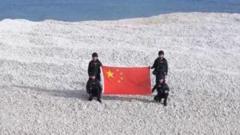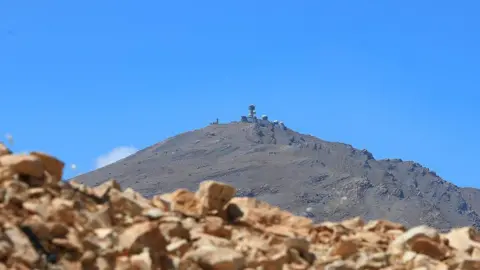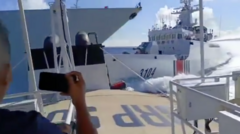China has intensified its claim in the South China Sea by seizing control of a minuscule sandbank, known as Sandy Cay. This move, reported by state media and accompanied by images of coastguard officers asserting control, has deepened the ongoing discord between China and the Philippines. The Chinese state broadcaster CCTV depicted coastguard personnel, adorned in black and clutching the national flag, asserting their presence on the disputed island.
Earlier in April, CCTV announced that China had officially "implemented maritime control and exercised sovereign jurisdiction" over the minor reef, further aggravating the situation in a region fraught with territorial disputes. In response, the Philippines has also engaged in assertive actions, landing on three separate sandbanks and releasing images echoing China's display, although it remains uncertain if one of these was Sandy Cay itself.
The National Task Force West Philippine Sea (NTF-WPS) has expressed grave concerns over what it described as the "illegal presence" of Chinese vessels nearby, reported to include a Coastguard ship and several militia vessels. Their statement emphasized the Philippines' commitment to defending its sovereignty amidst mounting tensions, describing the act of enforcing their presence as a vital assertion of national rights in the contested waters.
Sandy Cay is strategically close to Thitu Island (Pag-asa), where the Philippine military maintains surveillance over Chinese movements. Currently, there appears to be no permanent occupation by China on the sandbank, as reports indicate the departure of the coastguard from the location. The situation has drawn the attention of the US government, which has characterized the seizure as "deeply concerning," reiterating that such actions threaten regional stability and violate international law.
The recent developments coincide with the annual Balikatan military exercises, involving around 17,000 US and Philippine personnel. The White House has emphasized close consultation with partners in light of these tensions and warned against provocative military actions. US military drills, including live-fire exercises, are conducted to enhance national defense readiness, underscoring a commitment to counter threats in the region.
In recent months, US Defense officials have reaffirmed the alliance with the Philippines, urging for a re-establishment of deterrence against expanding Chinese influence. As the South China Sea dispute continues, the historical backdrop reveals a complication of territorial claims involving multiple nations including Vietnam, Taiwan, Malaysia, and Brunei, all of which vie for sovereignty over various islands and maritime zones in the area.
Earlier in April, CCTV announced that China had officially "implemented maritime control and exercised sovereign jurisdiction" over the minor reef, further aggravating the situation in a region fraught with territorial disputes. In response, the Philippines has also engaged in assertive actions, landing on three separate sandbanks and releasing images echoing China's display, although it remains uncertain if one of these was Sandy Cay itself.
The National Task Force West Philippine Sea (NTF-WPS) has expressed grave concerns over what it described as the "illegal presence" of Chinese vessels nearby, reported to include a Coastguard ship and several militia vessels. Their statement emphasized the Philippines' commitment to defending its sovereignty amidst mounting tensions, describing the act of enforcing their presence as a vital assertion of national rights in the contested waters.
Sandy Cay is strategically close to Thitu Island (Pag-asa), where the Philippine military maintains surveillance over Chinese movements. Currently, there appears to be no permanent occupation by China on the sandbank, as reports indicate the departure of the coastguard from the location. The situation has drawn the attention of the US government, which has characterized the seizure as "deeply concerning," reiterating that such actions threaten regional stability and violate international law.
The recent developments coincide with the annual Balikatan military exercises, involving around 17,000 US and Philippine personnel. The White House has emphasized close consultation with partners in light of these tensions and warned against provocative military actions. US military drills, including live-fire exercises, are conducted to enhance national defense readiness, underscoring a commitment to counter threats in the region.
In recent months, US Defense officials have reaffirmed the alliance with the Philippines, urging for a re-establishment of deterrence against expanding Chinese influence. As the South China Sea dispute continues, the historical backdrop reveals a complication of territorial claims involving multiple nations including Vietnam, Taiwan, Malaysia, and Brunei, all of which vie for sovereignty over various islands and maritime zones in the area.

















